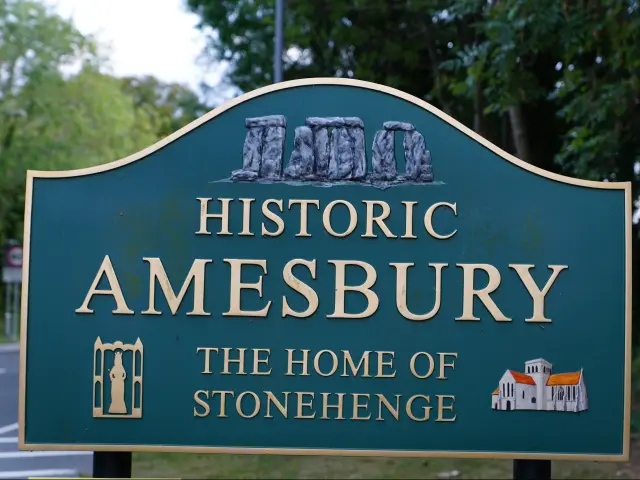Can you see Stonehenge from the Road?
Stonehenge in the south of England is famous for its prehistoric stone circle, built around 5,000 years ago, and visitors flock from around the world to marvel at this extraordinary monument, the largest of its kind anywhere on earth.
You can see Stonehenge directly from the road, but not from every road that passes it. You can drive the 85-mile route from London to Stonehenge in under 2 hours, passing many famous attractions en route with a good view of Stonehenge as you drive by.
The UNESCO World Heritage Site at Stonehenge covers an impressive 6,500 acres and has plenty to offer as well as the magnificent stone monument. Keep on reading to find out more about how to get there and things to see and do on arrival.
Can you see Stonehenge from the road?
Stonehenge is visible from the road, although this is dependent on the route you choose to arrive on. The A303 passes Stonehenge to the south and is the major road link between London and the southwest of England and it gives clear views of Stonehenge.
This route is often busy and the traffic will be going slow so it is likely you will get a good view of the stones as you drive past.
If you are arriving on another route, then it is not possible to see Stonehenge from the road.
How to reach Stonehenge
Stonehenge is located in the South of England on Salisbury Plain, Wiltshire, 2 miles from the nearby town of Amesbury.

This prehistoric wonder consists of a circle of standing stones weighing around 25 stones each, that originated in South Wales, and it is truly awe-inspiring to imagine how this incredible structure was created.
Being located in a central position in the south of England makes Stonehenge easily accessible and the journey relatively straightforward from almost anywhere in England, with excellent motorway and major A-road links within close proximity.
Driving to Stonehenge from London
Stonehenge is situated in the beautiful Salisbury countryside, a little over 85 miles to the west of London and the journey takes around 2 hours, although this is traffic dependent.
Leaving London heading west, there is a chance to catch many of the famous attractions such as Buckingham Palace, the River Thames, Hyde Park and Trafalgar Square as the A4 leads onto the A316 through Hammersmith and on towards Richmond, with its scenic park and home to the Royal Botanic Gardens at Kew, both of which are worth a visit if time allows.
The route continues passing the home of English rugby, Twickenham, before heading on to Sunbury-on-Thames where it merges into the M3, passing the Queen Mary Reservoir and Shepperton Studios before continuing onwards past Thorpe Park and the M25.
As you enter the Surrey countryside, the famous Wentworth Golf club at Sunningdale can be seen to the north before entering the county of Hampshire and passing Farnborough, home to the renowned International airshow, and Basingstoke, before taking the A303 west towards Andover.
The route then passes Stonehenge, it's impossible to miss the impressive stone structure to the right of the road, and a right turn at the next roundabout leads you along the A360 to the Stonehenge Visitor Centre and car park.
Driving to Stonehenge from Bath
Bath is situated to the northwest of Stonehenge in the county of Somerset. It lies around 35 miles from Stonehenge and the journey can be made in just under an hour.

The drive to Stonehenge from Bath is a pleasant drive through the delightful countryside. Leaving Bath, the route takes the A36 heading south passing the attractive villages of Norton St Phillip and Beckington, before reaching Warminster.
The National Trust site of Cley Hill is close by and the short climb to the summit gives amazing views over the surrounding area. Longleat Wildlife and Safari Park with its impressive Elizabethan House is also situated nearby and is well worth visiting.
Leaving Warminster, the route continues along the A36 passing the village of Heytesbury, before heading east on the B390 for several miles until it reaches the village of Shrewton, where the A360 will then lead all the way to the Stonehenge visitor centre and car park.
Reaching Stonehenge from Salisbury
Salisbury, famous for its incredible medieval cathedral, home to the original Magna Carta, is the nearest city to Stonehenge, lying 9 miles to the south of the neolithic wonder, and the journey takes around 20 minutes and is an easy trip for anyone wishing to visit.
Leaving Salisbury, the A360 heads north passing the Avon Valley nature reserve and Druids Lodge Polo Club before reaching the A303. Continuing straight ahead at the roundabout and staying on the A360 leads to the entrance to the Stonehenge visitor centre and car park.
Can you visit Stonehenge for free?
The majority of visitors to Stonehenge will park at the Visitor Centre and pay to enter the site. However, there are ways to see Stonehenge without having to pay.
There is a heritage trail that leads from Fargo Road in nearby Amesbury that follows a gravel pathway all the way to the Visitor Centre entrance. Rather than paying to enter, it is possible to follow the public pathway that runs next to the ticketed path.
Whilst you won't be able to walk around the monument in the same way as paying visitors, the views are equally impressive.
Stonehenge is synonymous with the summer and winter solstices where the monument's heel stone lines up with the rising sun in summer, and the sun sets to the southwest of the stones on the winter solstice.
Due to the importance of these events, admission is free at these times of the year and it is possible to walk amongst and touch the stones.
Members of the National Trust, and English Heritage, also receive free entrance to Stonehenge, along with hundreds of other historic and interesting attractions throughout the country.

Things you need to know about driving to Stonehenge
- As an outdoor attraction, it is best to visit in the summer months to enjoy the stones and capture them in their best light. This will be the busiest time of year for visitors, so spring or autumn would also be good times, to avoid the crowds.
- The best time to visit is early morning when the site opens, or a couple of hours before the site closes, as these tend to be the least busy times of the day.
- It is believed Stonehenge was built in alignment with the sun at the time of solstices, visiting at Spring Equinox and Summer and Winter Solstices will be busier than usual.
- The site is open all year round except on Christmas Day, and the opening times are 09:30 - 17:00.
- Booking a tour to visit at sunrise/sunset is a magical experience with amazing photo opportunities.
- Do allow for traffic congestion around Stonehenge and surrounding roads.
- Do consider joining National Trust or English Heritage. Not only will you get free access to Stonehenge, but also to hundreds of other historic and interesting attractions throughout the country.
- The fee to enter Stonehenge is £20 for adults and £12 for Children (5-17). There are family tickets available - 2 adults, 3 children costs £52, 1 adult and 3 children costs £32. It is advisable to book in advance as there is a 10% discount for doing so online.
- The Stone Circle Experience allows visitors to spend time inside the stone circle, mingling amidst the stones. The visit lasts for 1 hour and will take place outside the site's official opening and closing times. This experience has limited spaces available and costs £59 per person.
*Prices calculated at the time of writing

Things to do once you reach Stonehenge
A trip to Stonehenge will allow you to immerse yourself in the prehistoric world of our ancestors, see how they lived, and understand their way of life and their relationship with the natural world, and the sun.
Once you've arrived and parked at the visitor centre, some of the main attractions on offer are:
- Stonehenge Stone Circle - The incredible ring of stones is amazing at any time of year, and even more significant on the Summer and Winter Solstice. Learn all about the history and how the Solstice may be the reason behind the stones.
- Stonehenge Visitor Centre - Examine the incredible archaeological artefacts and treasures found on the site and discover all about the site from prehistorical times to the current day.
- Neolithic Houses - Take a tour around the reconstructed houses to learn all about how those that built the stone circle lived, and how their simple day-to-day lives make the construction of the stone circle even more impressive.
Whenever you choose to visit Stonehenge, the scale and magnitude of the stone construction are always impressive. The site is open all year round so whether it be taking in a summer sunset, or a dusting of winter snow, the spectacular Stonehenge always lives up to expectations so add it to your bucket list today.










